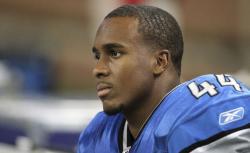There’s purpose in all-purpose yards. It’s a term usually only dragged out when someone puts up ridiculous numbers on both sides, like Michael Vick’s fantasy-breaking six-TD game against Washington last year. And it’s used in a dismissive way: As if using two methods to rack up yards somehow makes the sum less legitimate. But there’s value in having any skill position player who can serve two roles, and it’s subtly becoming a required part of the NFL offense.
I thought about this watching two guys who can’t seem to shake the charges that they’re not legitimate No. 1 backs: Jahvid Best and Matt Forte. Those criticisms are a result of looking at the box score and not the game. Maybe they’re not putting up gaudy numbers on the ground—Detroit and Chicago are 25th and 20th in the league in rushing—but those all-purpose yards are getting piled up. So what if Best could only manage 37 rushing yards against a killer Niners defense? Matthew Stafford still found him six times for 73 yards. And Forte led the Bears with six receptions, which is a pedestrian day for the man who leads the team in both catches and receiving yards.
This year, there are two backs in the NFL’s top five in receptions, and four in the top 20. Looking at the names and teams on that list, it’s easy to see who benefits. The pass-catching back is a great safety valve for young quarterbacks (Flacco, Freeman) or a quarterback without a stout offensive line (Cutler, Stafford). Having that short dump option is akin to running a 2TE set, without being as obvious or limiting. And sure enough, screen passes and yards after catch are on the rise.
I’d argue that the rise of the hybrid player is the spiritual descendant of the Wildcat craze. But whereas that was a hybrid formation, confining the dual threat to a single player accomplishes much the same thing without forfeiting a blocker. On any given play, there are only so many ways to gain yards: two or three receivers, one tight end, and one running back. Those are only four or five possible outcomes a defense has to guard against—so just mathematically, the offense has a better chance of a positive outcome with a player who has run-and-pass or catch-and-run abilities.
It’s not just pass-catching backs. Any skill position player with two skills adds value. Minnesota hands the ball off to Percy Harvin nearly as often as they throw it (or at least Donovan McNabb did), and Wildcat refugee Brad Smith is still listed as a receiver even though he almost exclusively carries the ball these days. And why not take it further? If Cleveland were clever or entertaining, they’d line up Peyton Hillis, who’s big enough to block, and Montario Hardesty, who’s got good enough hands to catch, at fullback and running back respectively. Paging Larry Csonka and Mercury Morris.
What does this mean for defenses, which are usually a few years slow in adapting to offensive philosophy shifts? (The 3-4 defense came back in vogue after two decades dormant in a run-first league.) Linebacker play becomes crucial—the most flexible part of the defense is uniquely equipped to deal with a flexible offensive playbook. Linebackers have gone top five in two of the last three drafts, with an emphasis on speed instead of strength. Mobility is becoming key everywhere, from corners and safeties who are fast enough to be return guys to a move away from 400-pound linemen. To make a libelous connection, the game becomes more wide open and faster at the same time HGH testing finally goes on the table.
Which leads to a second, more bloodthirsty point: If success in the NFL is all about bringing in the right personnel and running the right schemes (Al Davis knew this, once upon a time), there’s often little a head coach can actually do to help a team win during a game. There are more opportunities to screw something up than to do something right, and consequently there are only ever 10 to 15 competent coaches in the league at any one time. It’s amazing. So six weeks should be enough of a sample size to start calling for coaches’ heads.
Drew, I know you’re obsessed with the midseason firing, the ultimate admission that a team is shit. But if Tony Sparano and Steve Spagnuolo are still coaching, what does it take to lose your job around here?
Ideally, if things are shitty and obviously aren’t getting better, this is the time you’d start firing coaches. But teams tend to avoid pulling the trigger in midseason because premier free-agent coaches aren’t going to come along in midseason. So you get obvious lame ducks who’ve given up on their teams, whose teams have given up on them, and the ownership figures it might as well stick with one guy through the entirety of the Andrew Luck sweepstakes. You know, for consistency.
It was an all-around bad week for coaches, specifically Sean Payton’s fractured leg and torn MCL, and Jim Schwartz getting punked by Jim Harbaugh. (“I shook his hand too hard”? Harbaugh might as well have said, “You lost and you are a manbaby.”) Why do we get so much pleasure out of the plights of guys who don’t actually play football?
